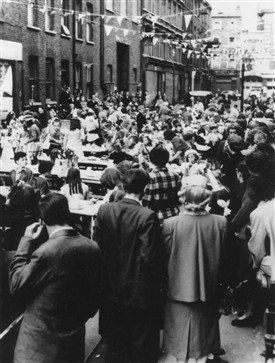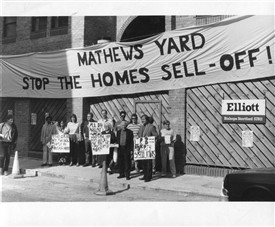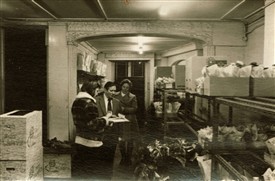Joan & Margaret Andrews
"It was a lovely place to live": growing up in Convent Garden
An interview conducted by Barbara Gallego Larrarte

Coronation celebrations in Covent Garden
Covent Garden Community Association

People demonstrating outside Mathews Yard
Covent Garden Community Association

The market before it moved to Nine Elms
Penny Saunders
Not often can one boast to have been born in the heart of London, but sisters’ Joan and Margaret Andrews both came into the world in 180 Drury Lane. Their childhood was framed by the Second World War, with Joan born three months after the outbreak and Margaret at the end of the war. In total, their parents had eight children, and the flat was divided between a room for the girls, one for the boys, another for the parents and a fourth room housing the living room and kitchen. Joan remembers being evacuated to Wales when she was only three years old. It was “horrible”, she said. With characteristic optimism, this assertion was quickly followed by the funny story of how the family could not understand her when she returned home with a Welsh accent. If there is something that stood out in my interview with the Andrews sisters it is their immense capacity for focusing on the positive side of life at every turn. This was never more pronounced that when they told me about growing up in post-war London. Although, Joan tells me, they “didn’t have any money” both sisters agree that theirs was “a lovely childhood”.
They cheerfully remember how, on Saturday mornings, they used to take their towels and a bar of soap to the Oasis swimming pool to use their showers. Back home, there was no bathroom and no shower. With a laugh, Margaret tells me that “the sink was on the landing”. They had gas lights, and had no electricity until “they went to work”. In case I might be getting the sense that these were difficult conditions to grow up in, Joan adds, “we managed and we turned out ok”. In fact, as Margaret says, and as our conversation shows, they have “some good memories”. A lot of these are about the freedom they had as children growing up in Covent Garden at that time. To illustrate how different things are today, Joan tells me a story she just heard about a girl being stopped by a policeman for playing hopscotch on the pavement. Joan is amazed by this, because they always “played out on the streets”. There were “no silly health and safety rules then”. Part of this freedom to play had to do with how different the world was then. Traffic in Covent Garden was predictable: when people left to work, when they returned and when the theatres started in the evening. Now the traffic is a constant interruption to the day. London had many bomb ruins because of the war, and children used them as places to play. The sisters explain how “kids weren’t afraid to play out in the streets”. This was partly because it was safer, but as Joan points out, it’s also because if someone saw you doing something wrong, they always knew your mother.
In this safer and quieter Covent Garden, Joan and Margaret tell me about their great childhood. “It was a lovely place to live”, Joan says. They played hopscotch and skipped in the street; they did the jitterbug to music from an old wind up gramophone; they followed behind the one man band that came to play in the area. Joan remembers sleeping into Trafalgar square on Coronation day to see the procession. Margaret was too young to join her. To celebrate the day, the Covent Garden shops and pubs all contributed so that the mothers and children could have an outing. Community life was the heart of the area. Neighbours knew each other. Both sisters tell me about the people living in their building, and they light up when they describe Muriel Gantry. She was “a character”, with “massive grey hair”, who made clothes for the theatre, her speciality being hats. But she also had an interest in Ancient Greek mythology, publishing The Distance Never Changes. She lived in the top floor of their house, and the only toilets for the whole building were also up there. One time, when their father went up, he came back to their flat saying “we’ve got dead bodies in the toilet”, because Gantry had installed shelves to store her dummies there. Margaret reflects on how “everybody got on with one another”. There were people from all over the world living in Covent Garden, but there was “no racial prejudice then”, says Joan, “because everybody mixed and got on”. At one of their brother’s birthday parties there were so many different nationalities present that someone said it was “like the League of Nations”.
Their father worked in the old fruit and vegetable market. He used to get up at four in the morning to head to work and then came home about one for his breakfast and a couple hours of sleep before heading back. He started working there when he was just “a little boy”, so his daughters imagine he would have been distraught by the market closing had he lived to see it. He also used to help move scenery at the Drury Lane theatre to get some extra money. The sisters tell me how, even though they could get all the fruit and vegetables they wanted, since their dad worked in the market, they still enjoyed the pleasure of pinching an apple or two when they went passed the stalls.
As they got a bit older, Joan and Margaret could enjoy the benefit of living walking distance away from the clubs in the West End. The sisters tell me how they used to sneak into a telephone box by their house to put make-up on before heading out, because their parents didn’t let them wear it. Then they left, without “a care in the world”, because the area felt so safe at the time. They started work when they were fifteen. With embarrassment, Margaret tells me how she always wanted to be a shop assistant, so she got her first job at Littlewoods, but hated it so much she was only there a week. After that, she worked doing the accounts for various businesses, while Joan was a legal secretary.
The GLC’s modernising plan for the Covent Garden area changed their family’s life. Their house was transformed into three separate flats, and they were rehoused to Brunswick centre in Russell Square. Margaret tells me how “it separated us from people that we knew, that we grew up with, but we still saw them”. In a sense, Joan thinks they were lucky to have been moved that close to Covent Garden. Although, she quickly adds, she “wouldn’t have gone” if they had rehoused them further away. The change was upsetting because it moved them from the community they knew so well, but it also had its benefits. They were now living in a modern flat with a bathroom and electricity. Even though returning to Covent Garden might have been a possibility, they did not want to pursue it, because they felt “happy” and “settled” in their new home. Their mother, however, “never settled”. She did not want to leave her home in Drury Lane: “her heart was there”. This was the plight of many Covent Garden residents at the time. The Andrews sisters told me how they went by their old home as it was being redeveloped to look at the changes, and the builder shouted “not another one!” because so many old residents were coming by to check on the state of their old houses.
When residents started to demonstrate in the 70s against the GLC’s redevelopment plans, the Andrews sisters joined them. They were particularly concerned about the older residents who found the whole process of moving from the place where they had lived their whole life a terrible “upheaval”. When I asked them what they think of Covent Garden as it is now, they both say they like it now. They are not fond of the traffic noise that offers “no respite”, but they mostly like what has been done with the area. They only wish the central market had a bit more character, with some of the old style shops, instead of so much “fancy food”. Both sisters recognise how much the area has changed since they were younger, but although they have some reservations about the new Covent Garden, their positive outlook prevails. Margaret thinks it is “for the good”, and Joan adds, “it’s progress”.
This interview was conducted as part of the Lottery Heritage Fund project, 'Gentlemen We've Had Enough: the Story of the Battle to Save Covent Garden'. On 10th May 2013 King's College London students, supported by Westminster Archives, the Covent Garden Community Association, and the Centre for Life-Writing Research at King's College London, interviewed Covent Garden residents about their memories of the area. Students' accounts of their interviews have been added to this Covent Garden Memories website. For more information please see: http://www.kcl.ac.uk/artshums/ahri/centres/lifewriting/gentlemen.aspx.'